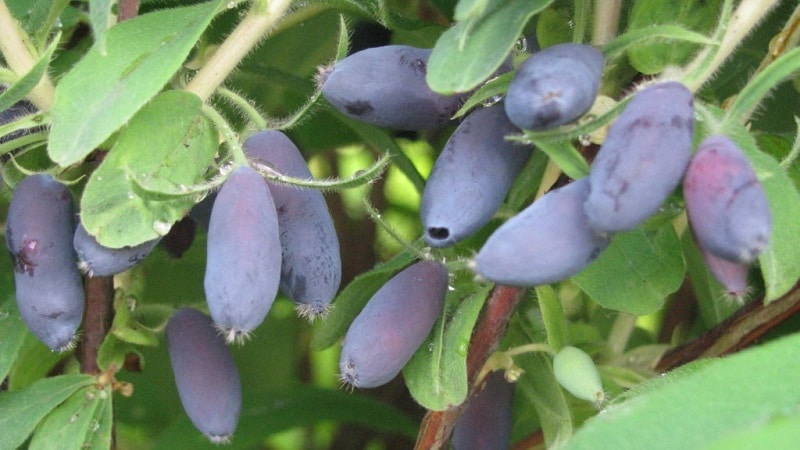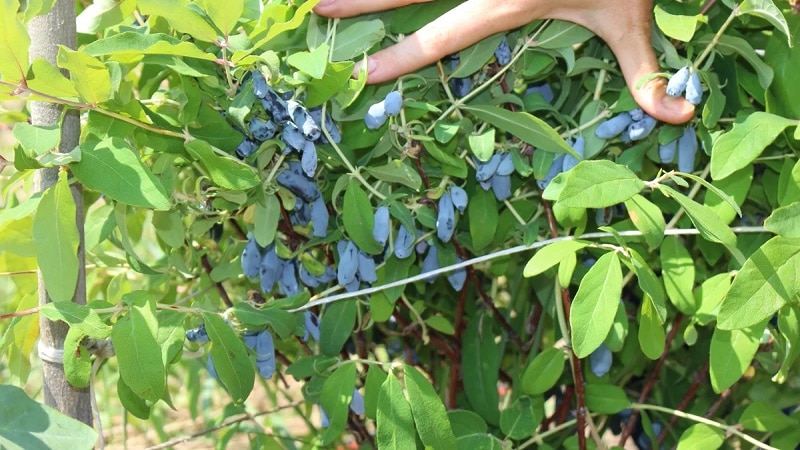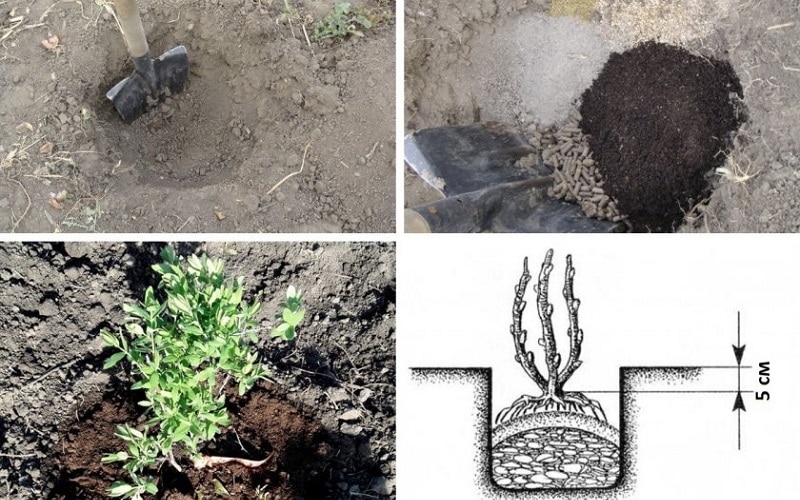Large-fruited frost-resistant honeysuckle variety Kamchadalka
Honeysuckle Kamchadalka is considered one of the best varieties created by breeders. This low shrub is unpretentious in care, resistant to low temperatures, and practically not susceptible to diseases and pest attacks. It is planted both to produce tasty berries and to decorate the garden plot.
Description of the honeysuckle variety Kamchadalka
This is an edible mid-season variety that was obtained through natural pollination.
Origin and development
Kamchadalka was sent for state variety testing in 1984. The work was carried out at the Bakcharsky stronghold - the northernmost nursery in Western Siberia.
The variety was bred from wild Kamchatka honeysuckle. The work was carried out by I. K. Gidzyuk and Z. I. Luchnik.

Characteristics, description of appearance, taste of berries
The bushes begin to produce crops already in the second year after planting. The plant is distinguished by its relatively small size and dense, narrow crown. Most often, Kamchadalka grows to a height of 1.5 m. It has smooth and long erect branches. The leaves are small, narrow, the surface is matte. The inflorescences consist of two small yellow flowers.
The berries are large, reaching 2.7 cm in length. The average weight of the fruit is 0.8–1.2 g. The shape is elongated, the skin is delicate and thin, the color is almost black, with a blue tinge. The pulp is sweet, juicy, fibrous, aromatic.
Features of application
Kamchadalka is grown for harvest and as an ornamental plant.The fruits are used in fresh and processed forms: various desserts, jams, compotes, etc. are prepared from them.
Productivity and fruiting, ripening period
The yield in Kamchadalka is average: about 1.5 kg of berries are harvested from one bush.
The harvest is being collected from late June to early July. The ripening of fruits is extended, so it is necessary to pick them several times.
Resistance to diseases and pests, cold and drought
Kamchadalka rarely gets sick and is affected by pests. Frost resistance is high, although there are varieties that can tolerate stronger colds. During drought, regular watering is required.
The shrub is approved for cultivation in all regions of Russia. Included in the State Register of the Russian Federation in 1993 for the West Siberian region.

Advantages and disadvantages of the variety
The main advantages of Kamchadalka:
- high frost resistance;
- good berry taste;
- ease of care;
- the possibility of using shrubs for decorative purposes.
Flaws:
- to obtain a harvest, the presence of other varieties of honeysuckle on the site is required;
- productivity not the highest.
Kamchadalka berries have good keeping quality and transportability compared to other varieties of honeysuckle, and do not fall off after ripening.
Agricultural technology
Growing shrubs often does not cause difficulties for gardeners: Kamchadalka is unpretentious and hardy.
Choosing a place in the garden and preparing holes
It is advisable to plant bushes in well-lit areas. The place must be protected from strong winds. Hills with dry soil are not suitable for Kamchadalka: there is a possibility that the bushes will not bloom, but will constantly increase green mass.
Important! The minimum depth of groundwater is 1 m from the ground surface.
The depth of the planting hole should be 50 cm and the diameter 40 cm.
During digging, the top layer of earth is thrown aside and later used to prepare a nutrient substrate. In addition to the soil, you will need 1 bucket of rotted manure, 2 tbsp. wood ash, 100 g superphosphate, 80 g potassium sulfate. All this is thoroughly mixed with turf soil, which was selected from the pit.
A drainage layer of dry branches about 10 cm thick is placed at the bottom of the hole. A mound of prepared substrate is made on top about 5 cm high below the edge of the hole. 1 bucket of water is poured into the hole and left for a week.
Preparation for planting and soil requirements
The roots of the plant are dipped in a weak solution of potassium permanganate for 15 minutes to disinfect. Then rinse with running water at room temperature.
Kamchadalka is best suited for fertile black soil. The shrub does not grow well on sandy soils. Optimal soil acidity is 5.5–6.5 pH. If the soil is highly acidified, a month before planting, add 200 g of lime or chalk per square meter.

Dates, scheme and rules of planting
In autumn, shrubs are planted at the end of September - before the arrival of frost, the seedlings will have time to take root. Spring planting is carried out when a stable positive temperature has been established.
Important! When planting in spring, there should be no blossoming buds on the bushes.
How to plant a plant:
- Place the seedling on the top of the mound so that the root collar is 5 cm above the soil level.
- Spread the roots and fill the hole with soil.
- Pour 2 buckets of warm water into the tree trunk circle and mulch the soil. Pine needles, straw or sawdust are suitable as mulch.
Features of cultivation
After watering, it is important to loosen so that air can flow to the roots, but do it very carefully, since the root system is located close to the surface of the earth.
Young bushes are watered as the soil dries, adults - 3 times a month. If the summer is very dry, the plants are moistened more often.
In the first 2 years, honeysuckle does not require fertilizer, since it was placed in the planting hole. Then organic matter is used. Fertilizing is carried out in the spring, after the snow melts. To do this, pour 1 bucket of humus under each bush, pour out 1 bucket of water with carbamide diluted in it (1 tbsp).
Trimmed only mature plants. The procedure is carried out in the fall: all root shoots, dry and damaged shoots are cut off. In the spring, the bush is inspected for the presence of frozen shoots. If there are any, they are removed.
Pollinators
Kamchadalka is self-sterile, so it requires pollinator varieties. Honeysuckle Iksa, Cinderella, Parabelskaya, In Memory of Gidzyuk are well suited. Breeders often use Kamchadalka to obtain other varieties.

Disease and pest control
The main pests that can threaten honeysuckle under unfavorable conditions are: aphid and honeysuckle fly. To combat them, contact insecticides are used.
Kamchadalka is resistant to diseases, but if it is not cared for properly or is moistened too often, it can be affected by fungal infections. Fungicides are used for treatment, but it is important to choose a product that will have time to be neutralized before harvesting the berries.
Preparing for winter
This is a winter-hardy variety, so it does not require shelter in most regions. Honeysuckle tolerates severe and prolonged frosts well. Only the ground under the bushes is mulched with a thick layer.Additionally, some gardeners throw fallen snow between the plants.
Reproduction
The variety is usually propagated by layering. To do this, part of the young shoot is dug in, after cutting the bark. After the appearance of their own root system, the cuttings are separated from the mother plant, resulting in a new seedling.
Difficulties in growing
Difficulties during cultivation arise only in the southern regions. Due to the climate, there is a possibility that the crop will bloom again. The berries will have time to ripen before the cold weather arrives, but this will have a bad effect on the harvest next season: the buds will be weak and diseased.
Another problem with growing in the southern regions is frequent winter thaws. Honeysuckle begins to bud within 3–5 days of warm weather. After this, the frosts return again. As a result, there is a risk that there will be no harvest this season.

Harvesting
Kamchadalka ripens gradually, so for complete harvesting it is necessary to pick the berries 2-3 times.
The fruits begin to be harvested at the end of June. They are removed by hand, because after ripening they do not fall off.
Tips and reviews from experienced gardeners
Many gardeners are happy with honeysuckle, but note low yields and instability to sudden temperature changes.
Victoria, Moscow region: “In my region, Kamchadalka produces good harvests. I planted 3 pollinators of other varieties nearby. Honeysuckle berries are tasty and large, but the yield is average. I collect about 1 kg of fruit from a bush.”.
Valentin, Krasnodar region: “I grow 5 varieties of honeysuckle. Kamchadalka planted 2 bushes, but only one survived. The berries are quite tasty, but the variety reacts very poorly to harsh weather conditions. When temperature changes, the yield decreases and the berries become less sweet.”.
Conclusion
Honeysuckle Kamchadalka is an excellent variety for growing in the country or in the garden, especially in cold regions. Although it is unpretentious in care, it is important to follow the basic rules of agricultural technology: choose the optimal place for planting, regularly water the bush.
Gardeners from the southern regions are better off choosing a different variety, as this one may not bear fruit well in warm climates.